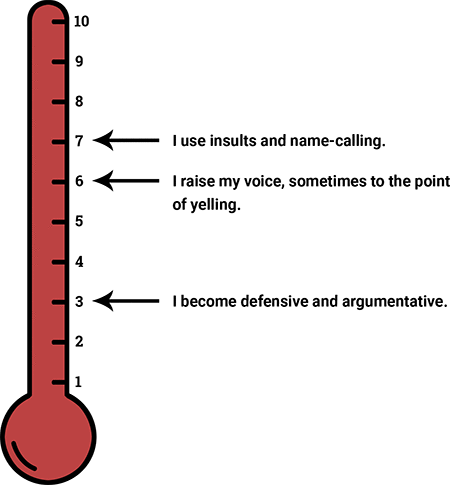The anger thermometer is a technique that will help your clients learn about their anger symptoms and warning signs, and how these progress as anger escalates.
An anger thermometer is a 10-point scale where a “10” represents a person’s maximum anger, and a “1” represents no anger at all. Symptoms of anger–such as balled-up fists, argumentativeness, or frustration–are recorded on the anger thermometer at the point where they begin.
Example: Someone who is just starting to feel angry might act defensively and argumentative. As they become more angry, they become aggressive by raising their voice and using insults. Here’s how these symptoms are recorded:
You may choose to use the anger thermometer to discuss anger triggers, as well. On the thermometer, record triggers based upon their intensity. This is a helpful way to associate specific symptoms and reactions with triggers.
Tip: Instruct your clients to begin by filling out the two extremes of their anger thermometer. What are they like at their most angry (“10”) and at their least angry (“1”)? These extremes tend to be the easiest to fill in, and they set the limits that all other symptoms will fall between.Anger Thermometer Exploration Questions
Therapists can help their clients complete anger thermometers by using questions and prompts that help them identify anger symptoms. In the following prompts, the numbers can be replaced with any number on the scale.
- “Tell me about a time you were at a 10 on the anger thermometer.”
- “When you’re at a 6 on the anger thermometer, what sort of things are you thinking about?”
- “How do you feel differently when you are at a 1 on the anger thermometer compared to a 5?”
- “If a stranger saw you when you were at an 8 on the anger thermometer, how would they describe you?”
- “Try thinking about your symptoms in reverse: What do you lose as you go up the anger thermometer? For example, maybe you are friendly and talkative at a 1, but not at a 5.”
Exploration Questions
Using a Completed Anger Thermometer
Anger Warning Signs
Oftentimes, people feel that they “snap,” instantly going from having no anger to having a full-blown outburst. Using an anger thermometer can help your clients recognize their anger warning signs. Anger warning signs are the earliest symptoms of anger, which often go unnoticed, but can be used to alert a person when their anger is growing.
It’s important to help your client take note of even the most subtle warning signs (the ones that appear when your client is below a “5” on the thermometer). Be thorough when completing the lower half of the anger thermometer, because recognizing these symptoms can be the deciding factor in stopping anger, or letting it grow out of control.
Anger warning signs are different for everyone, but often include some of the following. What are your client’s early anger warning signs?
| becoming argumentative | slightly raising voice | going quiet or "shutting down" |
| sweating | becoming defensive | feeling hot |
| nagging about the problem | pacing | using personal attacks |
Coping Strategies by Anger Level
Use the completed anger thermometer to plan coping strategies according to anger intensity. At what point should someone use a relaxation skill, and at what point should someone simply walk away? What coping skills should be used in the case of extreme anger, when a situation has grown out of control?
For example, if a person’s “3” on the anger thermometer is “becoming argumentative”, a good coping strategy may be to practice deep breathing. It is likely safe to practice a relaxation skill at this low level of anger, and deep breathing is an incompatible behavior with arguing (you cannot argue while practicing deep breathing).
However, if the situation escalates to a “5” and is at risk of escalating further, it may be best for the person to walk away. At an “8”, it is probably more appropriate to make a plan to call a friend, or resort to a safety plan.
Keep in mind that the best coping strategies vary from person to person, but using an anger thermometer provides an excellent framework for discussion.